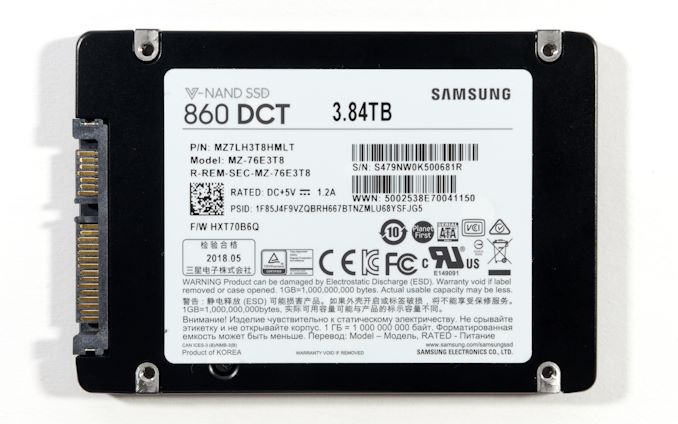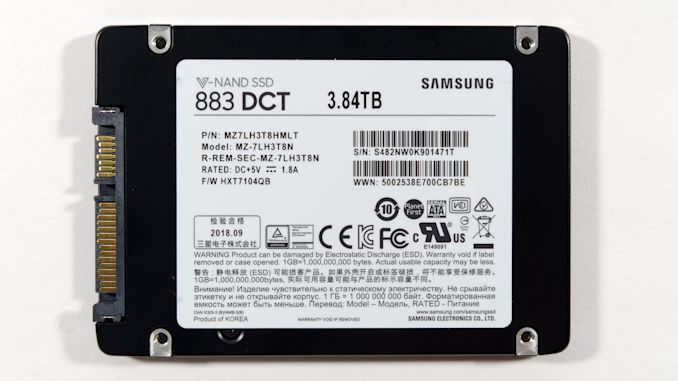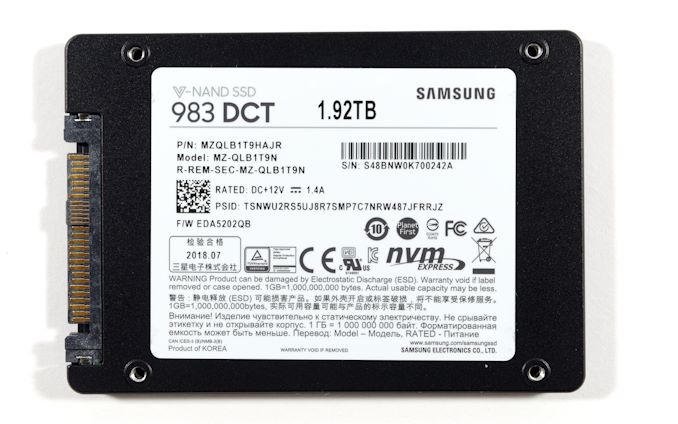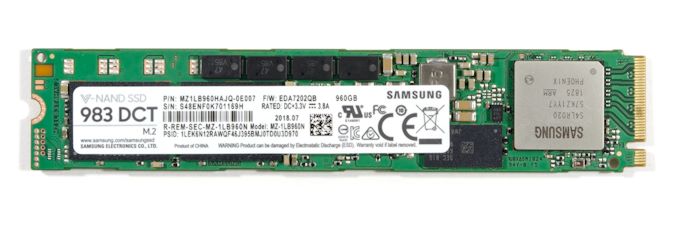The Enterpise TLC Storage Era Begins: Rounding Up 13 SSDs With Samsung, Intel, and Memblaze
by Billy Tallis on January 3, 2019 9:45 AM ESTSamsung's Latest Datacenter SSDs
In the latter half of this year, Samsung launched several new enterprise/datacenter SSD product lines. This is part of a new strategy to make its enterprise storage products more accessible to smaller customers. The 860 DCT, 883 DCT, 983 DCT and 983 ZET all use hardware that Samsung was already selling under different names, but are now being sold by retailers in individual quantities. We'll be testing the 983 ZET next month, but the other three new models have already survived our testing.
Samsung 860 DCT
The Samsung 860 DCT uses the same hardware as the 860 EVO consumer SSD, but with enterprise-oriented firmware. That means SLC caching is out and the firmware is optimized to provide consistent sustained performance, even though that means peak write speeds are far lower and the usable capacity is 4% lower due to increased overprovisioning. The 860 DCT also doesn't offer the idle power saving modes that consumer drives feature. The 860 DCT is an entry-level server drive that lacks many features traditionally associated with enterprise SSDs, most notably power loss protection capacitors. Like consumer SSDs, the 860 DCT operates with a volatile write cache, though this can be disabled at further cost to write performance.
| Samsung 860 DCT Specifications | ||||
| Capacity | 960 GB | 1.92 TB | 3.84 TB | |
| Controller | Samsung MJX | |||
| Form Factor | 2.5" 7mm SATA | |||
| NAND Flash | Samsung 64-layer 3D TLC | |||
| DRAM | 1 GB LPDDR4 | 2 GB LPDDR4 | 4 GB LPDDR4 | |
| Sequential Read | 550 MB/s | |||
| Sequential Write | 520 MB/s | |||
| Random Read | 98k IOPS | |||
| Random Write | 19k IOPS | |||
| Power Consumption | Read | 1.9 W | ||
| Write | 2.9 W | |||
| Idle | 1.05 W | |||
| Write Endurance | 349 TB 0.2 DWPD |
698 TB 0.2 DWPD |
1396 TB 0.2 DWPD |
|
| Warranty | 5 years | |||
The 860 DCT is intended for use primarily on very read-heavy workloads, with a very low volume of writes that preferably would be mostly sequential – for example, serving up streaming video. This is reflected by the write endurance rating of just 0.2 drive writes per day. Samsung doesn't intend for the 860 DCT to compete against any of their existing enterprise SSDs. Instead, they are targeting use cases where customers are currently using consumer-grade SSDs or mechanical hard drives.
This is pretty much the same description that everyone is giving for their first enterprise QLC SSDs, but the 860 DCT is still a TLC-based drive at this point. We expect its successor to switch to QLC NAND. Samsung says their currrent MJX controller can support 8TB SSDs, but so far they haven't gone beyond 4TB. As NAND and DRAM prices will continue to decline in 2019, it probably won't be long before they decide to max out the MJX controller.
The labeling on the 860 DCT differs slightly from Samsung's retail consumer SSDs, but inside we find exactly the same PCB, with components that differ only in date codes and lot numbers. Our 3.84 TB 860 DCT sample uses eight NAND packages each containing eight of Samsung's 512Gb 64-layer 3D TLC V-NAND, for a total raw capacity of 4 TiB.
Samsung 883 DCT
The Samsung 883 DCT is a more traditional enterprise SATA SSD, with the power loss protection capacitors that the 860 DCT lacks. The controller and NAND are still the same as in the 860 DCT and consumer 860 EVO. Random write performance is a bit better than the 860 DCT and the write endurance rating jumps up to 0.8 DWPD, a fairly mainstream value for enterprise drives intended to be used with read-heavy workloads.
The 883 DCT product line extends all the way down to 240GB where the 860 DCT family starts at 960GB. Samsung didn't sample the two smallest capacities of 883 DCT, but they are most likely to be used in applications that aren't performance-critical, such as OS boot drives. Samsung uses their smaller 256Gb TLC dies on the 960GB and smaller models, while the 1.92TB and 3.84TB models use the 512Gb TLC dies.
| Samsung 883 DCT Specifications | ||||||
| Capacity | 240 GB | 480 GB | 960 GB | 1.92 TB | 3.84 TB | |
| Controller | Samsung MJX | |||||
| Form Factor | 2.5" 7mm SATA | |||||
| NAND Flash | Samsung 256Gbit 64L 3D TLC | Samsung 512Gbit 64L 3D TLC | ||||
| DRAM | 512 MB LPDDR4 | 1 GB LPDDR4 | 2 GB LPDDR4 | 4 GB LPDDR4 | ||
| Sequential Read | 550 MB/s | |||||
| Sequential Write | 520 MB/s | |||||
| Random Read | 98k IOPS | |||||
| Random Write | 14k IOPS | 24k IOPS | 25k IOPS | 25k IOPS | 28k IOPS | |
| Power Consumption | Read | 3.6 W | ||||
| Write | 2.3 W | |||||
| Idle | 1.3 W | |||||
| Write Endurance | 341 TB 0.8 DWPD |
683 TB 0.8 DWPD |
1366 TB 0.8 DWPD |
2733 TB 0.8 DWPD |
5466 TB 0.8 DWPD |
|
| Warranty | 5 years | |||||
The addition of power loss protection capacitors doesn't require Samsung to adopt a larger PCB than the 860 DCT/860 EVO hardware, but it does give a more crowded layout. The 3.84 TB 883 DCT only has six large surface-mount capacitors plus empty pads on the back for two more, but there are enough other small components added that the large NAND, DRAM and controller packages had to be rearranged.
Samsung 983 DCT
The Samsung 983 DCT is an entry-level enterprise NVMe SSD. It has the same 0.8 drive writes per day endurance rating as the 883 DCT SATA drive, but boasts much higher performance. The 983 DCT uses the Samsung Phoenix controller that we are familiar with from the consumer 970 EVO and 970 PRO, and the OEM client PM981 SSDs. As usual, SLC caching is not implemented on the enterprise products, so write performance is substantially lower than what the consumer 970 EVO advertises, but read performance is similar.
The 983 DCT is only currently offered in two capacities: 960 GB and 1920GB, but customers also have their choice of M.2 or 2.5" U.2 form factors.
| Samsung 983 DCT Specifications | ||||||
| Capacity | 960 GB | 1.92 TB | 960 GB | 1.92 TB | ||
| Controller | Samsung Phoenix | |||||
| Form Factor | 2.5" 7mm U.2 | M.2 22110 | ||||
| Interface, Protocol | PCIe 3.0 x4 NVMe 1.2b | |||||
| NAND Flash | Samsung 256Gbit 64L 3D TLC | |||||
| DRAM | 1.5 GB LPDDR4 | 3 GB LPDDR4 | 1.5 GB LPDDR4 | 3 GB LPDDR4 | ||
| Sequential Read | 3000 MB/s | |||||
| Sequential Write | 1050 MB/s | 1900 MB/s | 1100 MB/s | 1400 MB/s | ||
| Random Read | 400k IOPS | 540k IOPS | 400k IOPS | 480k IOPS | ||
| Random Write | 40k IOPS | 50k IOPS | 38k IOPS | 42k IOPS | ||
| Power Consumption | Read | 8.7 W | 7.6 W | |||
| Write | 10.6 W | 8.0 W | ||||
| Idle | 4.0 W | 2.6 W | ||||
| Write Endurance | 1366 TB 0.8 DWPD |
2733 TB 0.8 DWPD |
1366 TB 0.8 DWPD |
2733 TB 0.8 DWPD |
||
| Warranty | 5 years | |||||
The M.2 version of the 983 DCT is rated to use significantly less power than the U.2 version. The 1.92 TB model is the only one that appears to have its performance meaningfully constrained by this, with sequential write speeds of 1.4GB/s instead of 1.9GB/s, and reduced random read and write performance.
The 983 DCT M.2 uses the 22x110mm card size, longer than the consumer standard of 80mm in order to accommodate the power loss protection capacitors. The 983 DCT M.2 is also double-sided, because unlike the 970 EVO it doesn't need to squeeze into thin laptops. This allows Samsung to use four NAND packages instead of two, and consequently shorter stacks of NAND dies.
The 2.5" version of the 983 DCT uses the same 7mm thick form factor as most SATA SSDs, but the construction is a bit different from Samsung's SATA drives: the screws holding the case together enter from the top instead of the bottom, and are covered by a label that puts Samsung's logo upside down relative to their SATA drives.
Inside, we find a PCB that uses almost all of the available space, with more than twice as many power loss protection capacitors as on the M.2 version. To keep all eight channels of the Phoenix controller busy and maximize performance, Samsung uses their 256Gb TLC dies on both capacities. The 983 DCT also features 50% more DRAM per GB of NAND than is common for SATA drives; some of this extra may be used for more robust ECC, but the primary purpose is most likely enabling higher performance.































36 Comments
View All Comments
ZeDestructor - Friday, January 4, 2019 - link
Could you do the MemBlaze drives too? I'm really curious how those behave under consumer workloads.mode_13h - Thursday, January 3, 2019 - link
At 13 ms, the Peak 4k Random Read (Latency) chart is likely showing the overhead of a pair of context switches for 3 of those drives. I'd be surprised if that result were reproducible.Billy Tallis - Thursday, January 3, 2019 - link
Those tail latencies are the result of far more than just a pair of context switches. The problem with those three drives is that they need really high queue depths to reach full throughput. Since that test used many threads each issuing one IO at a time, tail latencies get much worse once the number of threads outnumbers the number of (virtual) cores. The 64-thread latencies are reasonable, but the 99.9th and higher percentiles are many times worse for the 96+ thread iterations of the test. (The machine has 72 virtual cores.)The only way to max out those drive's throughput while avoiding the thrashing of too many threads is to re-write an application to use fewer threads that are issuing IO requests in batches with asynchronous APIs. That's not always an easy change to make in the real world, and for benchmarking purposes it's an extra variable that I didn't really want to dig into for this review (especially given how it complicates measuring latency).
I'm comfortable with some of the results being less than ideal as a reflection of how the CPU can sometimes bottleneck the fastest SSDs. Optimizing the benchmarks to reduce CPU usage doesn't necessarily make them more realistic.
CheapSushi - Friday, January 4, 2019 - link
Hey Billy. this is a bit of a tangent but do you think SSHDs will have any kind of resurgence? There hasn't been a refresh at all. The 2.5" SSHDs max out at about 2TB I believe with 8GB of MLC(?) NAND. Now that QLC is being pushed out and with fairly good SLC schemes, do you think SSHDs could still fill a gap in price + capacity + performance? Say, at least a modest bump to 6TB of platter with 128GB of QLC/SLC-turbo NAND? Or some kind of increase along those lines? I know most folks don't care about them anymore. But there's still something appealing to me about the combination.leexgx - Friday, January 4, 2019 - link
Sshd tend to use MLC, Only ones been interesting has been the Toshiba second gen sshds as they use some of the 8gb for write caching (from some Basic tests I have seen)where as seagate only caches commonly read locations
leexgx - Friday, January 4, 2019 - link
Very annoying the page reloadingWant to test second gen Toshiba but finding the right part number as they are using creptic part numbers
CheapSushi - Friday, January 4, 2019 - link
Ah, I was not aware of the ones from Toshiba, thanks for the heads up. Write caching seems the way to go for such a setup. Did the WD SSHD's do the same as Seagates?leexgx - Friday, January 11, 2019 - link
I have obtained the Toshiba mq01, mq02 and there h200 sshd all 500gb to test to see if write caching works (limit testing to 500mb writing at start see how it goes from Therethiagotech - Friday, January 4, 2019 - link
Can someone help me understanding which scenarios is considered as QD1 and higher? Does anyone have a guide for dummies what is queue depth? Lets suppose i'll start Windows and there is 200 files of 4k, is it a QD1 or QD64? Because i was copying a folder with a large number of tiny files and my Samsung 960 Pro reached like 70MBPS of copy speed, is really bad number...Greg100 - Saturday, January 5, 2019 - link
thiagotech,About queue depth during boot up a Windows check last post: https://forums.anandtech.com/threads/qd-1-workload...
About optimization Samsung 960 Pro performance check: "The SSD Reviewers Guide to SSD Optimization 2018" on thessdreview